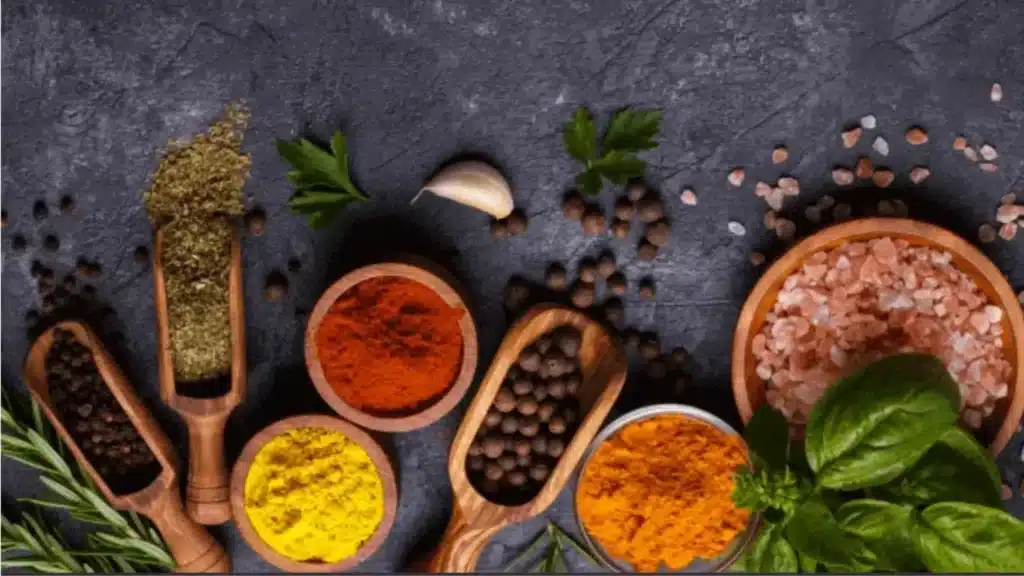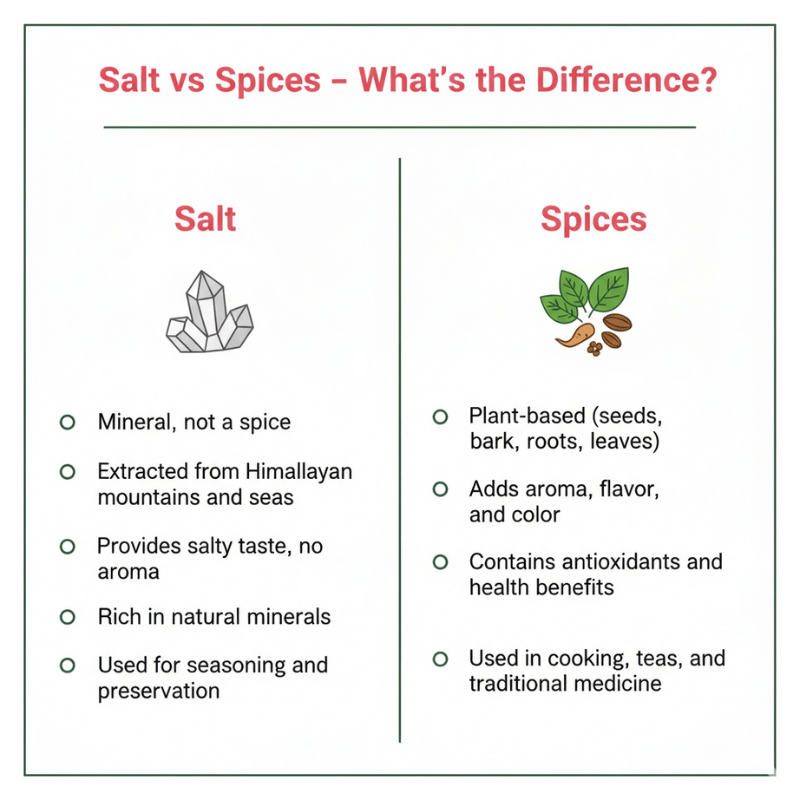Unraveling the Key Differences Between Salt and Spices in Cooking
- Zayan Rauf

No one talks about it much, but there are actually big differences between salt and spices. These two kitchen essentials are often used side by side, sometimes even interchangeably, but they’re not the same at all. Both play a unique role in cooking, flavoring, and even in health.
At Sobaan Salts, we believe in simplifying these food facts so you can make better choices for your meals. Let’s explore the clear differences between salt and spices in the easiest way possible.
Table of Contents

Is Salt Considered a Spice?
One of the most common questions people ask is: Is salt a spice?
The short answer is no.
- Salt is a mineral, mainly made of sodium chloride, mined from salt deposits or extracted from seawater.
- Spices, on the other hand, are plant-based; they come from seeds, roots, bark, or dried fruits.
So, while both are used to flavor food, salt is a seasoning, not a spice. There are Differences Between Salt and Spices. A 2023 study found that salt enhances taste perception by amplifying umami and savory flavors in foods like soups by up to 30%, while spices like turmeric and ginger add distinct aromatic notes without altering baseline taste intensity. [1]
What Are Spices?

Spices are what give dishes their distinct aroma, taste, and sometimes even color. They’re usually dried parts of plants and used in small amounts.
Examples include:
- Black pepper (adds sharpness)
- Cinnamon (sweet and warm)
- Cumin (earthy and nutty)
- Turmeric (bright yellow and slightly bitter)
Spices add layers of flavor and are often tied to culture and tradition.
What Is a Seasoning?
Seasonings are ingredients added to food to enhance taste.
- Salt is a seasoning.
- Spices are also seasonings, but not all seasonings are spices.
So, while both salt and spices fall under the “seasoning” category, they aren’t the same thing.
What Is a Condiment?
Condiments are extras you usually add at the table or while eating. They’re not cooked in but served alongside.
Examples: ketchup, mustard, mayonnaise, soy sauce, or chutneys.
This makes condiments different from both salt and spices.
Salt Is Not a Spice
Salt is a pure mineral. It doesn’t give a dish a brand-new flavor like spices do. Instead, it:
- Balances taste
- Enhances natural flavors
- Reduces bitterness
- Brings harmony to sweet, sour, and savory notes
That’s why salt is often called a flavor enhancer, not a flavor itself.
Read About: How to Use Himalayan Salt for Cooking
Did You Know?
Salt is the undisputed star of the kitchen, appearing as an ingredient in about 92% of recipes from a massive global database, while black pepper shows up in roughly 58% and cumin in around 38%, illustrating how spices bring exciting regional variety to salt’s everyday essential vibe.[2]
Functions of Salt in Food

Salt is powerful in cooking for four main reasons:
- Enhances Texture – in bread and baking, salt strengthens dough.
- Preserves Food – salt stops bacteria growth and keeps food fresh longer.
- Enhances Flavor – makes every ingredient taste more balanced.
- Health Essential – provides sodium needed for hydration, nerves, and muscles.
Explore: What is Himalayan Food
A 2022 sensory study showed that salt is detected on the tongue within 0.1 seconds, making it the fastest flavor enhancer, while spices like chili pepper require 0.5 seconds to register due to complex compounds. [3]
Spices and Their Unique Qualities
Spices are diverse and full of life. They can be sweet, sharp, earthy, or spicy. They not only bring flavor but also have antioxidant and medicinal properties.
Some examples:
- Black pepper → heat + depth
- Cinnamon → warm, sweet touch
- Ginger → spicy-sweet kick
- Turmeric → earthy + healing properties
A single meal with herbs and spices at culinary doses can improve 24-hour blood pressure profiles and reduce postprandial lipemia, unlike salt which may exacerbate these. [4]
Qualities of Spices
- Can be warming or cooling
- Vary in intensity depending on origin and storage
- Add both flavor and health benefits
Spices are often used creatively to tell the story of a dish, think garam masala in curries or cinnamon in apple pie.
Did You Know?
Adding 1g of salt to a dish increases sodium content by 400mg, directly impacting daily intake limits, while spices like paprika can replicate warmth and depth with zero sodium contribution. [5]
Seasoning Salt vs. Table Salt
This is where people often mix things up.
- Table Salt: Refined, often has additives, very common.
- Seasoning Salt: A mix of salt with spices/herbs (like garlic salt, onion salt).
If you want natural purity, Sobaan Salts Himalayan Pink Salt is the best alternative rich in minerals and unprocessed.
Everyday Cooking Examples
Here’s how you can see the difference in action:
- French Fries → salt = tasty, add paprika = smoky kick.
- Rice → salt = balanced, add cumin = aromatic.
- Soup → salt = base flavor, add garlic + pepper = full depth.
Salt brings out flavors; spices create new ones.
Discover: Types Of Salt For Cooking
How to Use Salt and Spices Together
Here’s a simple approach:
- Add a little salt early while cooking.
- Add spices gradually for aroma and complexity.
- Taste as you cook balance is everything.
- Finish with a touch of Himalayan salt for the perfect flavor boost.
Incorporating herbs and spices can reduce salt usage by up to 50% in dishes like chicken pasta while maintaining or boosting appetite and flavor acceptance. [6]
Quick Comparison: Salt vs Spices
Feature | Salt | Spices |
Origin | Mineral (sodium chloride) | Plant-based (seeds, roots, bark, etc.) |
Flavor | Salty, enhances taste | Wide range (sweet, spicy, earthy, bitter) |
Role in Food | Balances and enhances flavors | Creates new flavors |
Extra Use | Adds aroma & color | |
Health Value | Needed for body functions | Many carry antioxidants, anti-inflammatory properties |
Read About: Mineral Composition of Himalayan Pink Salt and Its 84 Natural Elements
Key Takeaways
- Salt and spices are not the same, salt is a mineral seasoning, while spices are plant-based flavorings.
- Salt enhances what’s already there, while spices transform flavors.
- Both are essential in cooking together, they create balance and excitement.
- Choosing natural, mineral-rich options like Sobaan Salts Himalayan Pink Salt makes your food both healthier and tastier.
At the end of the day, salt is the quiet hero that boosts flavor, while spices are the storytellers that bring dishes to life. Use both wisely, and you’ll never go wrong in the kitchen.
According to the National Institutes of Health, the average American consumes about 3,400 mg of sodium daily, exceeding the recommended limit of 2,300 mg, primarily from salt used in cooking and processed foods. Spices, however, contribute negligible sodium but offer antioxidant benefits, with studies showing turmeric’s curcumin can reduce inflammation by up to 30% in some cases.
Source: National Institutes of Health (NIH)
References:
- Gomes, S. et al. (2019). Nutrients: The Role of Salt in Human Nutrition. MDPI
- SciDirect (2022). The Multifunctional Role of Salt in Food Processing. ScienceDirect
- Khokhar, S. et al. (2022). Nutritional and Health Aspects of Spices. MDPI
- Smith, A. (2014). The Science of Spices and Seasonings. Google Books
Share This Post
Article By

Zayan Rauf is a dedicated writer with a passion for natural wellness and Himalayan salt products. With a strong interest in holistic living and sustainable sourcing, he shares valuable knowledge on how salt-based solutions can improve everyday life. At Sobaan Salts, Zayan is committed to helping readers discover the many benefits of mineral-rich products through clear, well-researched content.
our latest posts
The Data Shows:
The global sea salt market stood at approximately $20.5 billion in 2024 and is expected to reach $27.8 billion by 2032, growing at a steady rate of about 3.89% annually, fueled by demand in food, cosmetics, and industrial applications. [4]
